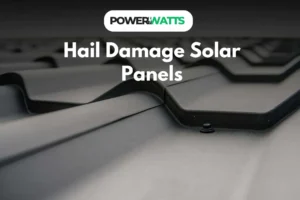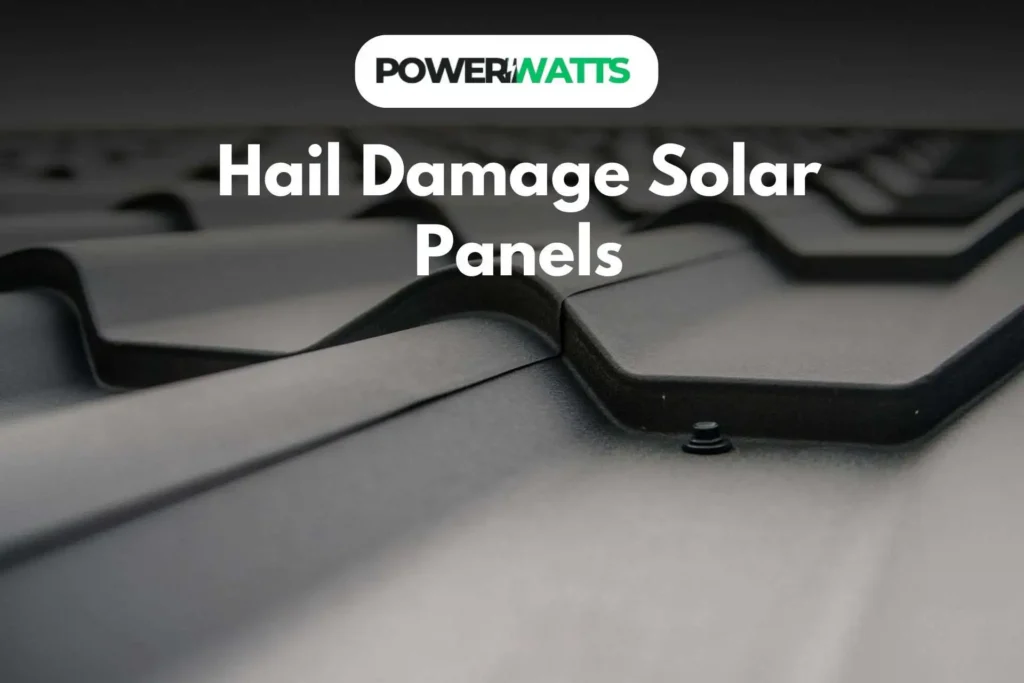Does hail damage solar panels? Solar panels are rapidly gaining momentum and becoming an excellent alternative for homes and businesses in their endeavors to reduce energy consumption while at the same time minimizing their carbon footprint.
However, the one commonly asked question by those willing to invest in solar panels is whether hail storms may destroy this costly investment.
With the high upfront cost of solar panels, understanding their resistance to hail and possible risks becomes quite crucial. It focuses on how solar panels hail, the kind of damage likely to occur, and the measures one may take to protect a solar installation.

The Toughness of Solar Panels
Contemporary photovoltaic panels are built to withstand all types of weather: heavy rain, snow, and even very extreme temperatures. As far as hailstorms are concerned, the manufacturing companies have made quite sufficient attempts at making it possible for these solar panels not to break upon the impact of hailstones.
Solar panels are usually made from toughened glass, way stronger than regular glass, and undergo serious testing long before they reach the market stage.
Tempered Glass Construction:
Most solar panels are constructed with a front surface made from tempered glass, which has strength around four to five times that of the standard glass. The construction of tempered glass is done in a manner to withstand impacts from hailstones, among others.
This is made possible by the strength of the tempered glass, which enables it to dissipate the energy from the hail without failing.
Testing Standards:
Before selling solar panels, they go through a hail simulation similar to that of industry standards. These tests generally involve shooting steel or ice balls at a very high speed into the panels, thus simulating a large hailstone’s impact.
In the U.S., solar panels are tested to standards laid down by the International Electrotechnical Commission (IEC), including hail impact resistance. Panels that pass these tests are certified to resist hailstones of a particular size at a specific speed.
Real-World Performance:
Despite this rigorous testing, the performance of solar panels in real hailstorms can vary. Speaking generally, solar panels have actually been proving to be quite resilient even at places considered ‘hailstorm-prone’, where hail storms come more frequently and with greater intensity.
For example, a solar farm in Colorado last year experienced less than 1% of its panels being damaged during the severe hailstorm that hit there in 2017, where hailstones the size of golf balls were reported.
Types of Hail Damage Solar Panels
While solar panels are built to be robust, under certain conditions specifically in a violent hailstorm some damage could be incurred. An understanding of the types of potential damage may create better awareness for risk assessment and preventive measures.
Surface Cracks:
The most prevalent type of hail damage is surface cracking. These may be minor and not even directly visible, but they can eventually impact the performance of the panel. Cracks in the tempered glass provide an entry point for moisture to enter the panel, which can cause internal damage and reduce efficiency.
Frame Damage:
Besides the surface of the glass, hailstones of large size may also cause damage to the aluminum frame of the solar panel. Dented or bent frames may not directly influence the generation of electricity by the panels but might weaken the structural integrity of an installation. This can lead to problems, which include water infiltration and panel misalignment.
Cell Damage:
Severe hailstorms, though seldom experienced, can still cause destruction to the photovoltaic cells inside the panel. Hailstones that pass through the top glass layer may destroy the cells and drastically reduce energy output. This kind of damage usually requires the replacement of those panels.
Displacement or Mounting Issues:
In rare instances, hail storms of the order of extremely high magnitude coupled with strong winds displace the panels from their mounting systems. Misalignment or, in worse conditions, torn panels out of their mounts can cause severe damage.

Protective Measures for Solar Panels against Hail
In light of the risks involved, more can still be done to safeguard home and business owners from potential hail damage to solar panels. Even though the danger of serious damage is low, these actions can help to further reassure you.
Use high-quality panels:
High-quality solar panels that have passed strict tests are a primary line of defense against hail damage. For this reason, when selecting models of solar panels, consider those with larger hailstones and higher impact velocities. Durability ratings of the panel and customer reviews further inform on real-world performance.
Install protective covers or guards:
In regions where hailstorm incidences are very high, protective covers or guards over the panels provide extra protection.
These covers are made with materials like polycarbonate, which absorb hailstones and their impact without impeding the panel’s function of generating electrical energy. Other companies even make hail-resistant netting installed over the solar arrays.
Regular Maintenance and Inspections:
Quite a good number of solar panel problems may be avoided by routine maintenance and inspection. Hailstorms may, for instance, require an individual to conduct an immediate review of any possible damages to the panels, such as cracks or dents.
Detection of such occurrences at an early stage may allow for repairs or replacements on time, reducing further impacts on the performance of the general system.
Insurance Cover:
Homeowners need to check their insurance policies if, in the case of damage from a hail storm, it already includes the solar panel installation.
Many of the homeowners’ policies already have solar panel coverage in them, but it’s good to check the specifics of the policy they have down to the limits and deductibles.
Sometimes, extra insurance related to the installation of solar might be advisable.
Strategic Placement:
During installation, good strategic placement may reduce the exposure of solar panels to hail. The panels can be installed at an increased angle that may deflect the hailstones rather than absorb full impacts.
Placement in less exposed areas, other than by direct wind and hail on the lower sections of roofs, for example, can minimize the risk of damage.
What to Do If Your Solar Panels Are Damaged by Hail
When solar panels get destroyed due to hail, it is highly recommended that one take immediate action pertaining to the degree of damage and further course of action in terms of repair or replacement.
Damage Inspection:
Perform a visual inspection of your solar panels after a hailstorm. Check for any cracks, dents, or signs that an impact may have occurred. If the damage is slight and superficial, the panels will continue to work, but their performance needs to be checked for any problems.
Call in a Professional:
At the sight of any damage, it will be wise to seek the services of a professional solar installer or technician who could assess the situation. They would carry out more detailed scrutiny and establish whether the damages are superficially cosmetic or if they further extend to affect the performance of the panel.
In some instances, such panels may need to be replaced in order for the efficient running of the system.
File an Insurance Claim:
If the damage is extreme, then you will want to submit an insurance claim for repairs or replacements. Most immediately, contact your insurance provider to report any damages and initiate the claims process.
Be certain to photograph the damages and document any information relevant to your claim.
Consider upgrading:
If such solar panels are irreparably damaged, it may be time to switch to more resistant new models.
It is due to this reason that the advances in solar technologies have actually meant that newer panels do better and become more efficient and resistant to environmental influences such as hail.
Conclusion
Solar panels are normally very durable and built to operate effectively in every kind of environment, even in hail. While there is a possibility of hail damage, these modern solar panels have tempered glass that has been put through several rigorous tests in order to make them withstand the impact energies released by hailstones.
One would make sure that high-quality panels were chosen, prevention methods were taken, and there was adequate insurance to cover the homeowners’ solar investment against hail effects.
If hail does manage to break your solar panels and that is extremely unlikely prompt inspection and repair can minimize its long-term impacts on system performance.
But as solar technology continues to evolve, the resistance of solar panels to hail and other environmental elements will only increase, further bolstering solar energy’s desirability and dependability in service to a livable future.
Get a Quote In case you are interested in integrating an inverter with a solar charger into your power system, do not hesitate to contact us today for your custom quote.


